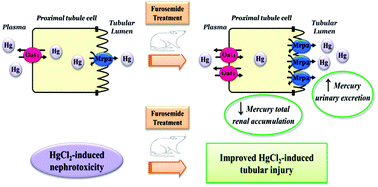Amelioration of mercury nephrotoxicity after pharmacological manipulation of organic anion transporter 1 (Oat1) and multidrug resistance-associated protein 2 (Mrp2) with furosemide
Abstract
Inorganic mercury is a major environmental contaminant. The primary site of mercury-induced injury is the kidney due to the uptake of Hg(2+)-conjugated organic anions in the proximal tubule, primarily across the organic anion transporter 1 (Oat1) at the basolateral membrane. At the luminal side, mercuric ions are eliminated by the multidrug resistance-associated protein 2 (Mrp2). It was demonstrated that furosemide treatment induces up-regulation of Oat1 renal expression. As novel preventive and therapeutic strategies based on pharmacological manipulation of drug transporters are emerging, this study was designed to evaluate the impact of furosemide modulation of Oat1 on the nephrotoxicity induced by HgCl2. Wistar rats were treated with furosemide (6 mg per 100 g per day, s.c.) for 4 days or with HgCl2 (4 mg kg−1, i.p.) 18 h before the experiments or with furosemide for 4 days before the HgCl2 injection. Furosemide treatment improved HgCl2-induced tubular injury as assessed by urinary alkaline phosphatase activity, urinary glucose, Oat5 urinary excretion and histopathological studies. Besides, administration of furosemide enhanced urinary excretion of mercury, reduced mercury total renal accumulation and increased Mrp2 renal expression. In summary, furosemide improves HgCl2-induced proximal tubule injury up-regulating mercury transporters, thus increasing renal elimination of the mercuric ions. Hence, pharmacological manipulation of mercury transporters with furosemide might be a preventive strategy to reduce mercury toxicity.


 Please wait while we load your content...
Please wait while we load your content...